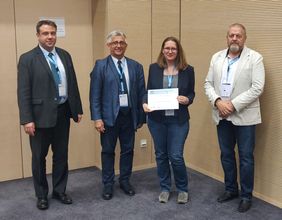BestOralPresenation@I3S für Larissa Egger
Larissa hat bei der I3S Konferenz in Warschau 2022 für ihren Vortrag “Efficient screening of hybrid nanomaterials for optimizing chemical sensor devices” den “BestOralPresenation Award” gewinnen können.
Liebe Larissa, wir gratulieren herzlich zu dieser Auszeichnung!
#mcl_leoben #weinnovatematerials #I3S2022warsaw
***
BestOralPresenation@I3S for Larissa Egger
Larissa has won the "BestOralPresenation Award" at the I3S conference in Warsaw 2022 for her presentation "Efficient screening of hybrid nanomaterials for optimizing chemical sensor devices".
Great job Larissa, congratulations to this award!
#mcl_leoben #weinnovatematerials #I3S2022warsaw
***
Abstract:
Chemical sensors based on metal oxides (MOx), are one of the most promising gas sensing devices due to their high sensitivity to numerous gases, fast response, miniaturization, and simple production. The detection principle of these sensors is a conductivity change of the MOx sensing material due to chemical reactions of gases with surface molecules. Cross sensitivities and interference to humidity, however, are still significant drawbacks of these sensors.
Functionalization of MOx sensing films with catalytic nanoparticles (NP) is a highly promising technology for optimizing sensor performance. The huge variety of potential MOx - NP-combinations requires efficient screening technologies to find proper hybrid material mixtures which enable controlled adjustment of the sensor response to specific target gases. This is of high importance for realization of a multi gas sensor device capable for clear discrimination of single gas components out of a gas mixture.
In this work we introduce our approach for efficient screening of hybrid MOx – NP material combinations. We have developed a specific Si-platform chip along with a gas measurement setup which enables simultaneous characterization of 16 chemical sensor structures in parallel. The Si-chips feature an array of Ti/Pt electrodes for contacting ultrathin MOx sensing films, which are deposited by spray pyrolysis and structured by photolithography to a size of 50 x 100 µm2. On these platform chips we tested three different MOx (SnO2, ZnO, and CuO) before and after functionalization with mono- and bimetallic NPs (such as Au, Pt, Pd, and NiPt) towards several test gases (CO, HCmix, toluene, CO2). Measurements are performed in a background gas of synthetic air at different relative humidity levels (25 – 75%) and at different operating temperatures up tp 350°C. We will present the sensing performance results of various MOx-NP combinations exhibiting an optimized response to specific target gases.



















